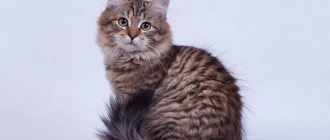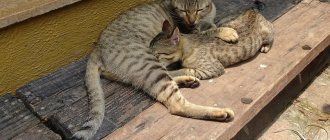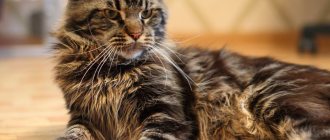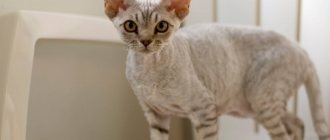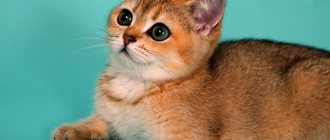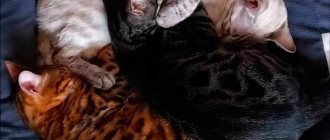About tabby color in cats
Everyone has seen tabby cats, but not everyone knows that their coloring is correctly called tabby. We can talk about this color when darkened patterns appear on the light-colored coat of the animal: stains, stripes, spots, lines. Sometimes the tabby color is disparagingly called ordinary, which is fundamentally wrong: cats with many stripes, necklaces, spots on the body, with bracelets on their paws and a tiara on the head in the form of a large letter “M”, dark eyeliner and nose look elegant and interesting.
Features of character and behavior
Siberians have a Siberian character, which is manifested in the following traits:
- sociable, but not annoying;
- independent;
- smart;
- balanced, friendly;
- curious;
- brave.
The Siberian cat has a stern appearance, which can create a deceptive impression. Yes, these cats are stingy with emotions, but they are very kind and love affection from their owner. But they can also show independence. You can’t force hugs or scratching behind the ears on them if they don’t want it.
Types of tabby colors in cats
Among the variety of tabby colors there are:
- Marble tabby
is a very beautiful color, in which the cat’s head is crowned with a pattern in the form of the letter “M”, the eyes and nose are lined with a dark color, and there are horizontal stripes in the cheek area. The neck, paws and tail are entwined with rings and bracelets. And on the back and sides there are fancy patterns, similar to those on marble: ornate rings, streaks, curls and ovals;
- Tiger tabby
- this color is similar to marble tabby in the presence of decorations on the head (the letter “M”, stripes and strokes in the eye and cheek areas), markings on the neck, belly, paws and tail. A distinctive feature of the tiger tabby is considered to be clear stripes on the body, which are similar in appearance to tiger stripes;
- Spotted tabby
- in addition to the large “M” on the head, there are horizontal dark lines from the eyes, and lines on the cheeks are also noticeable. There is a dark broken line along the ridge, and on the sides there are numerous round and oval dot patterns. The tail has rings and is dark at the tip. Bracelets are visible on the paws, and several rows of necklaces on the neck; - Ticked (or Abyssinian) tabby
is the most subtle color of the entire tabby variety. With a ticked tabby, the pattern on the head in the shape of “M” is clearly visible, as well as the rings on the tail, the bracelets on the limbs and necklaces on the neck are almost blurred, and each of the hairs is colored simultaneously in several colors. A clear pattern on the body is not visible.
Now let's look at some of the most popular coat colors of tabby cats:
- Tabby point
- this color means that the animal has a light shade of fur (say, ivory) on the body, but the darkest shade of fur on the tips of the ears, in the area of the nose, paws and tail. Plus there is a tabby pattern;
- Blue tabby
- the light gray coat shows distinct dark gray (blue) tabby stripes in the head, neck, body, paws and tail;
- Silver tabby
- in cats with this color, the hair from the roots is half white, and at the tips it is blue (gray) or black, and tabby patterns are distributed throughout the fur coat;
- The tortoiseshell tabby
is a predominantly black and red spotted breed with well-defined tabby markings.
How to choose a kitten
A purebred kitten can only be bought in nurseries, a club or at an exhibition. Purchasing through private advertisements increases the risk of having a sick pet or an ordinary yard kitten. Only a felinologist can distinguish a real Siberian cat.
A purebred Siberian cat must have a pedigree that includes at least 3 generations of animals that fully comply with the standard.
You can reserve a kitten using a photo, but a visit to the nursery is required. Key points to pay attention to when choosing a kitten:
- The baby should not be either too timid or aggressive. React adequately to affection and sit calmly in a person’s arms.
- The kitten is adopted at the age of 2.5-3 months, when the first vaccinations have been done and toilet training and scratching post have been completed. It is recommended to adopt show-class kittens at least 5 months old. At this age, it is possible to evaluate the appearance, determine compliance with the standard and predict a show career.
- Inspect the fur for parasites and dandruff. Hair should be healthy and shiny.
- A healthy kitten has clean ears and eyes without discharge. Everything is clean under the tail too. The baby should be moderately well-fed. Kittens at the age of 3 months can weigh 700-800 grams.
- White Siberian kittens, especially those with blue eyes, are tested for deafness.
Cost of Siberian kittens
In many ways, how much a Siberian kitten costs depends on its belonging to the breed class:
- Pet class or pets are not shown and are not allowed to be bred. In nurseries the price can be 10-30 thousand rubles. (+\- 5-10 thousand)
- The most common breed class is - such animals can participate in breeding and cost more - 30-60 thousand rubles.
- The best representatives of the breed - show class Siberian kittens - are highly valued. The cost starts from 60 thousand rubles.
Tabby cat breeds
Now we list the most popular tabby cat breeds:
Abyssinian cat
– The most common of the Abyssinian colors is the wild, ticked tabby. The fur looks red-brown, but each hair is colored in several shades at once - from light red to brown and black, which gives the impression that the color shimmers with light-dark shades of brown. From the patterns, stripes in the form of “M” and darkening at the tip of the tail are noticeable;
British tabby cat
– the most common coat color of pets of this breed is blue, but there are other colors, for example, tortoiseshell, rare black, white, lilac and fawn. Among the British there are also individuals with tabby and tabby point colors;
Scottish tabby cats
(Scottish folds and Scottish straights) - such pets with hanging and straight ears can be solid solid (black, red, white, etc.), smoky and colors combined with white spots. But straight-eared and fold-eared cats with patterns on their fur, for example, silver, blue or brown tabbies, look especially impressive;
Siberian tabby cat
– this beauty, who is our compatriot, can also be tabby in color. The luxurious striped color looks especially beautiful on the thick, semi-long coat of Siberian cats;
Persian tabby cat
– fluffy Persians come in different colors, including their coats and tabby patterns. It’s just that it’s not always possible to clearly see marble stains or tiger stripes on such a long and thick coat. However, the characteristic letter “M” on the forehead and the rings on the tail are almost always clearly visible;
Pixie-bob tabby
- It’s funny, but these popular cats today with short tails and tufts on their ears, first bred in Canada, are mistaken by some people for ordinary outbred animals that have lost part of their tail after getting into trouble. The color of pixie-bob cats is chocolate or gray-gray of varying saturation with the obligatory tabby markings;
Kurilian Bobtail Tabby
- a young Russian breed bred in the 90s of the 20th century. The color of such cats can be decorated with tabby patterns, but provided that the main coat color is not fawn, lilac, chocolate or cinnamon. But black, red (red), cream, blue, silver, tortoiseshell tabby (possibly with white spots) are not prohibited by the breed standard;
Thai tabby cat
– it is more correct to talk about the color of animals of this breed “Thai tabby point cat”. These pets have the main part of their fur white, and the ears, tip of the muzzle, paws and tail are colored brown, blue, red or cream. In addition, Thai tabbies have characteristic markings on their bodies (for example, tiger stripes or small circles on the body, the letter “M” on the head, rings on the tail, etc.). It is noteworthy that Thai kittens are born white, and only then point spots of a different color and characteristic tabby markings appear on their coats;
Singapore tabby cat
– in color, miniature Singapuras are a little similar to Abyssinian cats, only their fur is light cream, with brown shading on the face, back and tip of the tail. The eyes and miniature nose of these pets appear circled. Each coat of Singapore ticked tabbies is colored in several shades at the same time - from almost white to chocolate brown. It is noteworthy that all Singapore cats are the same color;
Asian tabby cat
– we are talking about Bengal, Sumatran cats and fishing cats – wild animals living in Asian countries. Sometimes they are kept as pets, but by nature they are free animals. Their fur coats also show distinct tabby patterns, which are not used as decoration at all, but for camouflage during hunting.
Origin story
Large cats living in Siberia have been known since the 16th century. However, the people of this region led a nomadic lifestyle and did not have cats, so there are 2 versions according to which they ended up there:
- Brought by Asian traders from Bukhara, that’s why they were called Bukhara.
- We moved along with immigrants from western Russia.
According to researchers, a forest cat took part in the formation of the breed, with whom “foreign” cats could mate when they found themselves in the wild. After crossing, a unique long coat appeared, which allowed it to survive in harsh conditions.
For quite a long time, the Russian Siberian cat was associated with the Norwegian Forest cat and was exhibited under that name at the first exhibitions.
They began to engage in breeding work in 1986. Having decided to isolate the breed, the name “Moscow Semi-Longhair” was proposed, but then they chose “Siberian”. A large, muscular animal with thick, dense fur, it was associated with the large northern region of Siberia. In 1989, the breed was registered in the USSR.
The breed standard was written in 1990 and sent to international felinological organizations. In 1992 it was recognized and published by WCF. Since 1996, recognition began by world organizations: TICA, FIFe, CFA.
The Siberian cat is the first Russian breed to be recognized abroad.
In 1997, an additional description and characteristics were added to the standard, according to which the Siberian cat was finally distinguished from the Norwegian Forest and Maine Coon breeds.
A Russian cat named Dimka Tender Beast in 1994 became the first World Champion in the history of the Siberian cat breed.
Interesting facts about tabby color
- According to the beliefs of many peoples of the world, tabby cats promise their owners good luck in all endeavors
: from love affairs to financial success; - There is an interesting legend regarding the origin of the name “tabby”
. Allegedly, the name of the color was given in honor of the Attabiya quarter of the Iraqi city of Baghdad, from where in the 17th-18th centuries. fabrics of amazing beauty with unusual moire patterns were supplied to English cities. Some people thought that the stripes on a cat’s fur coat looked like fabric patterns with fancy patterns; - Tabby color is considered the most ancient, natural color
. It was with these characteristic patterns that cats existed in ancient times. But they didn’t need the stripes for beauty, but for camouflage from potential victims and larger predators; - In the popular dream book of Felomena there is an explanation that seeing a striped cat in a dream
means unexpected luck or a date with a wonderful, unusual person; - Many felinologists and cat lovers believe that tabby-colored pets have the best health
. And all thanks to a special gene, which is responsible for the wild striped color, and is also directly related to the animal’s immunity; - All cats with red (red) and cream fur have stripes on their coats
. It’s just that sometimes they are not expressed too brightly, and therefore it seems as if the animal’s color is monochromatic and solid, but this is not so.
Advantages and disadvantages
Like any other cat breed, the Siberian cat has its own characteristic features.
Advantages of the breed:
- playful, affectionate, gentle;
- gets along well with children;
- unpretentious;
- quickly gets accustomed to the toilet and scratching post.
Disadvantages of the breed:
- may be willful;
- restless;
- suffers from mood swings and does not always respond in kind to the owner’s affection;
- Requires daily brushing during shedding.
There is a version that the Siberian breed is hypoallergenic. However, there are no completely hypoallergenic cats. People with allergies, to make sure whether a Siberian will cause a reaction, can spend several hours in his company and finally decide whether to get this breed.
Disqualifying Faults
In addition to the reasons common to representatives of all breeds (non-conformity, color falsification, unkempt appearance, signs of disease, the presence of parasites, aggressiveness, oligo- and polydactyly, cryptorchidism in cats, tail defects)
The grounds for disqualifying a Siberian cat are:
- pronounced signs of the Persian type;
- deafness of cats and white cats (according to the rules of European rings);
- umbilical and inguinal hernias (Neva masquerade hernias are susceptible to their occurrence).
This is interesting! However, situations where Siberian cats are deprived of an exhibition rating are quite rare: high standard qualities and good health are signs reinforced by the professional, serious work of Russian felinologists.
Return to content
The Case of the Redheads
Spotted cat - examples of breeds and their names
However, there is an exception to this series. The fact is that the influence of the “non-agouti” allele on the “O” (“Orange”) gene is excluded. It is because of this that naturally occurring ginger cats (cream-colored) should have such an intriguing tabby coloring. Meanwhile, the “solid” cream color (very wide, differently colored stripes, as if identical to the human eye) is the result of long-term work by breeding specialists.
Important! All "furry enigmas" potentially have tabby coloring in their genetic "menu". Evidence of this is the residual effect in many kittens (“ghost”, baby tabby). However, after molting, it becomes uniformly colored throughout its entire body. Consequently, not all cats exhibit genotype “A” (agouti), which is what leads to the desired effect.
Our conclusions
Today we talked about the specific colors of different cat breeds, how this color can change as the cat grows up, and how to choose a kitten of the color you need. We hope our recommendations and advice will help you not make mistakes. But, if you still have questions on this topic, we will be happy to answer them.
What color is the cat or cat that lives in your house? Let's try together to determine the most popular color of cats among our readers... For example, I have a black British Scottish Fold at home)))
We are waiting for your feedback and comments, join our VKontakte group!
Color variety
The most popular among animals with similar colors are silver tabby and gray cats, which have markings of different tones. Smoky black and reddish, blue and chocolate, lilac color shades may be present here. Other tabby colors are also available. Among them are black silver tabby, amber, blue silver, cameo, caramel, chestnut and many others.
Important! It should be noted that this coloring largely depends on the existing pattern. Thus, the classic (marble) version of the pattern combines various dark stripes with a light base background of the “fur coat”. In the spotted version, the pattern plays with “warm” tones. The mackerel variant combines darkish stripes on a silver and gray base. In turn, with the ticked subtype, almost all colors possible in the cat world are found.
TOP 10 popular varieties
Often the tabby or piebald color of a cat is mixed with snow-white. The one-color tone is a kind of “knee socks” on the legs and spots on the belly. The tiger color occupies exactly half of the body, the rest is covered with white.
- Clouded Leopard - The image is similar to lynx fur and resembles marble in combination with a steel color.
- Silver (silver) implies a dark image on a snow-white color.
- Rosette - a variation of piebald coloring, visually the spots resemble rosettes. Most often found in the Bengal breed.
- Blue - a grayish or azure pattern on light wool.
- Brown is distinguished by a dark outline on a red-brown color.
- Black silver is characteristic of the British breed. The main color is silver with black outlines.
- Sil - found mainly in the Thai breed. Pale chestnut spots are located on a cream color.
- Blue, chocolate, lilac, cream, golden points are found with corresponding colors on a pale, light background.
- Red – stands out because the background color is peach.
- Chocolate in Silver – based on a silver-blue background with chocolate outlines.
Solid colors
If a cat is completely the same color, it means it is “solid”. Solid colors were developed due to the suppression of recessive tabby genes. There are cases when the pattern is not completely suppressed, then a fuzzy shadow tabby is noticeable. If you look at a black leopard, you can see the outline of the pattern, since the leopard also has similar suppressed genes.
Cream and red colors cannot suppress tabbies effectively, so the pattern on these animals is always present to a greater or lesser extent. The monochromatic white color is obtained by the action of different genes that completely suppress the color. Many white kittens have vague shades on the head, where the color is not completely suppressed, this goes away with age.
Black MCO n
Blue MCO a
Red MCO d
Cream MCO e
White MCO w

